History of Howden Shops & Inns - Part Two
This is part two of a history of Howden shops and inns and covers mainly Bridgegate, St Helen's Square, Cornmarket Hill, Churchside and Highbridge.
Click here to go back and read part one.
Have a look at the old photos page for more pictures of Howden. All pictures are available either as prints or as digital images.
See also the page which refers specifically to Howden Market Place and also Irene Bancroft's memories of Howden.
Bridgegate from the Co-op towards Cornmarket Hill
Now we cross the entrance to Market Place and continue with the Co-op shop, formerly the Half Moon Inn. To read more about the Half Moon, have a look at the Market Place section on this website.
Mr William Armstrong, tailor
Memories: After the present Co-op premises was Armstrong's. Mr Armstrong was a tailor. He was very gentlemanly.
He died in 1944 aged 88. Mr and Mrs Armstrong's daughter Edith Mary married Charles Buttle in 1914. They had children Ronnie, Joyce, and Douglas Buttle.
Memories: The Buttles lived with the Armstrongs. In church Miss Morris, Mrs Kemp and Mrs Buttle used to sit in the pews behind the choir stalls. The shop later was Deeleys and sold knitting wool etc.
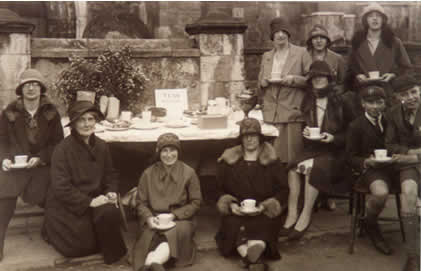
Drinking tea on Cornmarket Hill are from left: Miss M Moore, Miss Hetty West, Mrs Megson, Miss P Sunderland, Mrs Buttle, Bessie Bruines, Miss Dorrie Shaw (all three standing); seated Miss Sunderland and Ron and Doug Buttle
Britannia Inn
Next was the Britannia. This was originally the Grapes but had been renamed The Britannia by 1839. In 1854 the landlord was William Clayton, who later was well-known as landlord of the Half Moon.
The landlord in 1920 was George Greason who had married Angelina, the widow of former landlord Edward Ainley in 1910. Sadly Mrs Angelina Greason was widowed for a second time when Mr Greason died in 1921. Mrs Greason stayed on as landlady but in 1930 there was a new landlord at the Britannia when Billy Walker moved there from the Sotheron Arms in Hook.
It was later kept for many years by his daughter Miss Edie Walker.
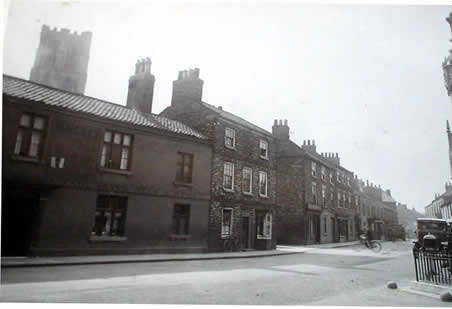
A view of Bridgegate with the Britannia on the
left. and Hodgsons' shop a little further along
Hodgsons' shop
Memories: Next was barber Harry Hodgson. It was about 2d for a haircut. He used to come and sort of sing to you - he used to stop cutting and watch when the East Yorkshire bus came in. It was a fascinating shop. He had a copper cistern for water.
His wife sold fruit. She had a little warehouse down Vicar Lane. Barry Walker remembers taking 'taties' there from Les Shaw's. He carried a ton of taties down that lane and she said "By, you work well" and gave him a threepenny bit. Ron Palmer used to take tomatoes and vegetables there from the market garden at Knedlington Manor in a two wheeled truck.
Next, across the lane, Westlakes had a fish and chip shop.
Mr Soanes the saddler
John Henry Soanes saddler's shop was next to Bridgegate Fisheries and was part of the original King's Head pub.
Memories: Saddler Soanes used to repair binder canvases, school satchels - in fact he used to make satchels, then went into shoes. He was married to Edith and had two daughters, Mary and Margaret. Mary was once carnival queen. She died quite young.
Mr Soanes came originally from Middleton on the Wolds. The shop was a druggists and was later rented by Mr Durham as a saddlers. Mr Soanes was Mr Durham's apprentice. He took it on from Mr Durham and bought the property around 1926/7. He was the last saddler there.
Mrs Tasker's shop, no 64 Bridgegate
This was earlier the premises of William Draycott, a baker. Later it was run by a Miss Draycott.
Memories: Some people remember it as Mrs Tasker's. She sold pies and it was rumoured it was horsemeat in them [I think this was a joke!]. She also sold buns. She later had a cafe.
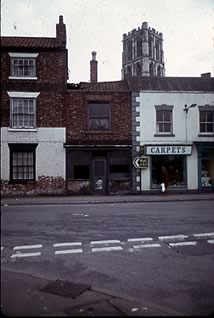
The premises fell into disrepair, as can be seen above and were restored by Mr Ian Mason, as can be seen in the picture below. It is now a delicatessen.
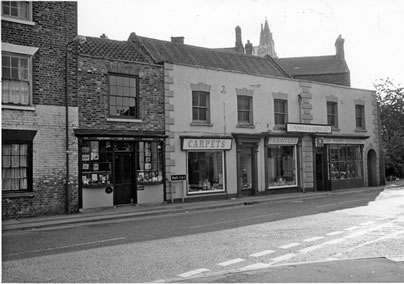
Powls' shop
Powls' shop sold furniture, bicycles, motorbikes, petrol and many other items
Mr Ken Powls, writing in 2005, remembered how,
'One of my brothers, Cecil, was a pioneer in the new miracle, the wireless. He had a charging shed built at the back of our garage in St. John Street and started a business charging wireless batteries which were brought in about once a week. He was no organiser and often forgot to label the batteries with their owner’s name and so we had constant arguments in the shop about the ownership of the batteries. He sometimes forgot to put them on charge and so there was also a constant knocking on the door when somebody’s wireless had gone dead during the 10 o’clock news. The batteries were filled with sulphuric acid and so there was always an acid smell in the shop.
We sold crockery, which was delivered to us on a railway horse and cart from the station. It was packed in straw in a wicker basket and it was left in the street until we were ready to unpack it.The most sought after thing that we sold were tins of carbide to replenish carbide lamps. Theselamps depended on a drip of water on to the carbide, which produced a flame, but they were very tricky and depended on the exact amount of water to drip. Oil lamp glass funnels were also in greatdemand because lights were turned up too high and the glass cracked. There was a constant demand for 6d cycle repair outfits for the punctured inner tubes.
Paraffin was pumped up from a drum that we had in the shop and we sold it in any receptacle,mainly milk jugs, for the oil lamps which were then the only means of lighting apart from candles.Petrol for the few cars on the road came in 2 gallon tins and we had a funnel which filled the tin topour the petrol into the car. Red tins were for Shell and green tins for Pratts. Eventually we had a petrol pump installed in the doorway of number 86 Bridgegate with a 500 gallon tank dug in thefloor. We sold R.O.P. petrol (Russian Oil Products) which did not go down very well with the local residents because anything Russian was considered not quite rightAnother constant demand was from people wanting to use our telephone which was fixed to the wall. We never knew how much the call cost so presumably my father thought of a number and doubled it. This service was night and day'
Mr Powls has written several books about the history of Howden, including his memoir entitled Many Lives.
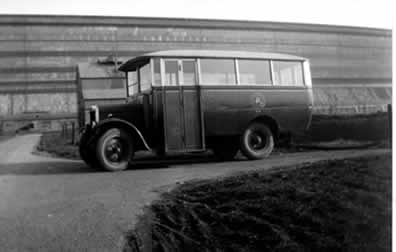
The Powls family had a Dennis bus and in the 1920s ran a regular service taking workers to the nearby airship station where the airship R100 was being constructed. The airship hangar is shown here in the background.
'Simmy Rutter'
Memories: He was a cobbler. His shop was between Powls' shop and Spiveys chemist. It has been demolished. He had a a pair of miniature shoes in his shop window. It was very dark inside, as were many shops then.
Spiveys chemist
Memories: Next was Spiveys chemist, on the corner of Cornmarket Hill. Mr Spivey sold all sorts - sheep dip, liniment etc - mainly agricultural stuff. There were big bottles in impressive colours, red and green. There was one big one with a royal coat of arms on it - a massive thing.
Bridgegate and St Helen's Square
Now we go back to the other side of Bridgegate and start at Batty Lane.
Across Batty Lane
Memories: There were cottages down Batty or Angel Lane. AG Rae, the chemist, had his warehouse and Johnsons lived down there.
Alf O'Connor who had one eye always used to stand on the corner near Wilf Hodgson's. Wilf Hodgson was a barber. There was a little side door into his shop from Batty Lane.
Draycotts and Wilf Hodgson
Memories: Where Screetons estate agents is now, was Draycotts' butchers'. After Mr John Draycott's death in 1936 his two daughters continued the business until they sold out to the Co-op in the early 1950s. They ran the shop helped by Harry Batty. The slaughter house is now Screetons car park. Tom Batty, who was a pig killer, worked for Tommy Moore. His brother Harry worked for Draycotts.
The two Draycott sisters, Phyllis and Dora, were very keen tennis players. Their sister Charlotte was blind but played at the Shire Hall.
Additional memories come from the granddaughter of Maud Draycott:
'My grandmother was Maud Draycott who was born
in Howden on 15th May 1897. Her father was a butcher, and she had
sisters Phyllis, Dora, Enid and Charlotte or Lottie as she was known.
Lottie was blind but a good pianist. These ladies were my great
aunts and the only one I did not meet was Lottie. She suffered from
epilepsy and died quite young. She did, however, receive a piano
diploma in her lifetime which my brother has framed and hanging
in his house.
I have heard many stories about my maternal grandmother's
family and all the sisters were very hard working and extremely
tough. Dora and Phyllis both lost their fiancées in the First
World War and never married. They lived together in Prestatyn in
North Wales just round the corner from my grandmother, Maud, who
I used to visit often. The butcher's was also where they slaughtered
the animals and I have heard tell that the sisters' job on
returning from school was to wash down the walls and yard of blood
from the day's slaughtering.'
Alexander George Rae, chemist
Memories: Next to the butcher's was Mr A G
Rae, chemist. He was usually known as George. The previous chemist
was a Mr ?Akam. Mr Rae was an officer in the Home Guard; his cousin/sister
Mrs Bell lived with him. He was in business there until he died
in 1979.
Eric Watson used to go round selling chemist's stuff out of a van.
Mr Rae had his own brand of cosmetics called 'Marvell'
which he made up.
We used to get stockings from the shop and setting lotion, which was a bit green and used to come out in great blobs.
He always drove those Citroens called 'Light Fifteen'. He had a couple of St. Bernards. You could get the purple cough mixture which was oil of almonds, syrup of violets and syrup of squills(?), whatever they were. He mixed that up. The shop was full of drawers with all the Latin names of the drugs.
He always looked pale, unlike Mrs Bell. She used to advise on how to put on make up – she was always fully made-up at any time of day. She'd come into the shop in these lacy negligees.
It was said that after the war the floor of the dispensary was rotten and underneath was full of water and there was telephone equipment down there from when it was the post office.
Gilbert Dudley, tobacconist
The shop to the left of the chemist's was for many years a tobacco and confectionery shop. It was run by the Rhodes family in the early 1900s.
Henry Rhodes, his wife and at least 10 children came to Howden from near Bingley by 1881 and lived in Churchside. Henry ran a small market garden. By 1901 Henry and wife were living at this shop whilst their son John Henry was the postmaster and lived next door at the Post Office. Another son, Arthur, was living elsewhere in the town and was a painter and decorator
Later the tobacconist was Teddy Wilson and then came Mr and Mrs Gilbert Dudley.
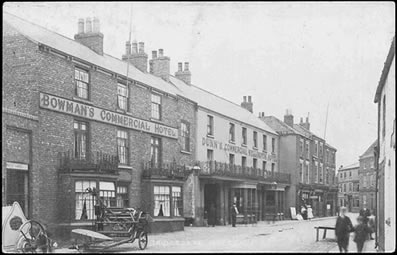
Above is a view of both the Bowman's and Wellington inns in Bridgegate. On the extreme left is agricultural machinery outside what was Glews' implement showroom.
The Wellington
The Wellington was known in the eighteenth century as the White Hart Inn and a lease of a property called 'White Hart in Briggate' was recorded as early as 1724.
An advertisement in the York Herald of January 1813 invites contestants to take part in 'Howden Cockings to be fought in Mr Fosters's Pit, White Hart Inn'. An amazing prize of £100 was offered for the winner of a match between 'cocks or stags' of over four and half pounds. The birds were allowed to wear blinkers and were to wear 'fair silver gaffs' (artificial spurs). A pair of cocks would be 'on the sod' each day at 11am.
The Wellington was a stopping point for stage-coaches travelling between Liverpool and Hull. The stage coach The Eclipse called here on its way to Liverpool at 8am and on its journey back to Hull at 6pm.
In the 1820s the inn was renamed in honour of the famous Duke, victor at Waterloo, and was owned by Robert Daniel and then Francis Hutton.
The landlord in 1823 was William Bowman and later in the 1830s the inn was kept by George Galtress. An additional storey was added to the Wellington in 1864 to cater for the increased trade brought by the visit of the Yorkshire Show to Howden. It was then owned by and run by J. Sherburn. The Wellington yard contained many stables and was the site of pig and cattle markets.
Around 1900 Isaac Dunn was the landlord and he had his name painted prominently across the front of the inn. By 1911 Isaac Dunn had left Howden and was running the Duke of Cumberland in Cottingham.
Landlords also included Isaac Murphy in 1913, 'Billy Hewison' and H. B. Jones in 1940.
The Bowmans
The Bowmans took its name from John Bowman [1795-1858] who was brought up at The Wellington where his father William was landlord. John worked as a farrier and veterinary surgeon but by 1839 he was landlord of the Half Moon. By 1851 he had bought the former Nag's Head across the road and renamed it Bowman's Commercial Hotel and Posting House.
In 1864 the Yorkshire Show was held in Howden and extra accommodation was built at the rear of the hotel. By 1876 it had stabling for 85 horses, 18 bedrooms and a smithy in the yard.
The landlord of the Bowmans in 1911 was Thomas Shaw, originally from Faxfleet, and his wife Charlotte. Living with them was their daughter Ethelia who was married to Harry Matthews, a horsebreaker.
The Congregational chapel and St Helen's Square
Next came Glews' implement showroom and Nurse Oliver's house. Then there was the Congregational chapel with the Milton Rooms behind.
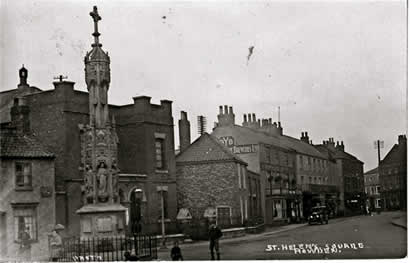
On the left is the Congregational chapel with the war memorial in the foreground
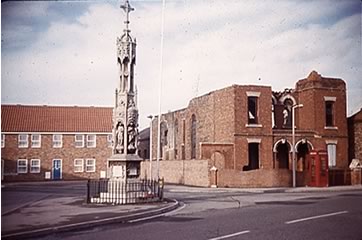
This picture was taken in the 1980s as the chapel was being demolished. You can see the new housing to the rear.
The area behind the War Memorial, St Helen's Square, is now very different and most of the original houses have gone. The former premises of Fred White, joiner and undertaker, are still there. Another row of cottages has now gone and on the end was a fish and chip shop.
Memories: There are many memories of this fish and chip shop known as 'Ma Grayburns'. Arthur remembered 'young' Bill Walton He used to go into Ma Grayburn’s fish and chip shop in St. Helen's Square, where the one who shouted loudest got served - there was no queue. He used to shout, "Give us two Ma, give us two". The old fashioned chipper was at one end of the counter. Pa and Ma Grayburn would be going like mad. She'd say, "Chop us some chips somebody," so the nearest customer would do it. So much for shop hygiene.
At Grayburns were two or three wooden topped tables. You got served at the counter and then ate at tables.
Arthur Bancroft's shop was on the corner of Northolmby St, opposite Powls'. It stood right onto the kerb - it was pulled down and is now where the council built flats. They sold cakes, groceries etc. Arthur Bancroft was a fireman and had a brother who played the trombone.
The shop was formerly kept by Dicky Eden who went to Hook.
In Northolmby Street was Bert Randall who was a plumber. Across the road was joiner and undertaker George Cawkill at no 3.
The Black Bull
Between Northolmby Sreett and St John's Street was the Black Bull, now the premises of the Lower Ouse Internal drainage board.
In the eighteenth century the Black Bull was owned by the Lowther family. William Lowther, who died in 1739, and his wife Priscilla owned the inn. Priscilla, who died in 1764, was, according to the ale house licences, the licensee until her death and she then left the inn to her son Matthew who was listed as licensee in 1777.
The landlord in the 1820s was Moses Jewitt.
Preston Swallow was the landlord of the Black Bull in 1911. He was a 70-year-old former gardener from Pontefract.
The last landlady was Mrs Mary Harding who gave up the tenancy in 1936.
Miss Bruines
On the opposite corner was the fancy goods 'repository' or shop kept by Miss Hannah Rigby who died in 1909.
Miss Bruines had this shop later selling fancy goods. It is now part of Minster View.
The Black Swan
Next door at the Black Swan the landlady in the early 20th century was Mary Bearpark. She retired and went to live with her daughter and son-in-law West Anderson. By 1911 George Rippon was the landlord, although he was a former soldier and soon rejoined his regiment when the war broke out.
The next landlord in 1917 was John Gill, who moved in with his wife Jane and their family. John also ran a taxi service. He died suddenly in 1919 and his son Leslie, then not quite 15, took over the taxi driving. His brother Ralph, who was killed in 1933, and sister Stella joined him as drivers.
The Gills - Leslie and his son Don - were later based at 79/81 Hailgate and for the next 60 years drove most Howden families to their weddings and funerals and most family events in between. Leslie also managed the Majestic Cinema, now the East Riding Customer Services premises, until 1956.
Meanwhile Blyth Backhouse, a potato merchant, was at the Black Swan. His wife was a keen badminton player.
Arthur Swales
Memories: Next was Arthur Swales' shop. Old Mrs Swales had arthritis badly and she used to sit in the back of the shop. Sarah Pooley, who had come from the workhouse to look after Mrs Swales, served. They sold tomatoes etc. Their son was Fred Swales.
Churchside
Now we go down Churchside.
Memories: Down Churchside was 'Cis' Coopers shop. Barry remembered that she sold all sorts including toffees. If she weighed it and was too much she'd bite a bit off. With tomatoes she'd keep changing them until she got the right weight.
Also here was Kirbys hairdressers which was was where Vi Philips lived. She ran a dance school. There was a dancing troupe and a yearly panto. They went touring to Wales. People remembered a Renee Ali, supposedly a West End star, who used to come on in pantomime dressed in top-hat and tails singing 'Following in father's footsteps, I’m following my dear old dad'. She used to be smoking. She used to do cartwheels and keep the top hat going. Panto was on for a week in the Milton Rooms.
The old Co-op was on Church side. The church bought it for a youth club. The top part of it was used for parties. In the old Co-op a man called Wood served for a time. They had sawdust on the floor.
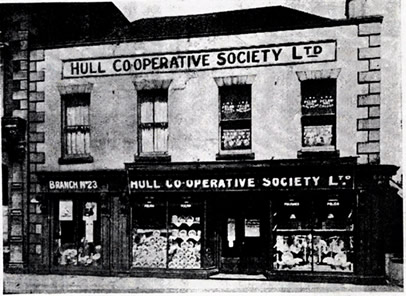
The old Howden Co-op. It has been demolished and is now [2011] being replaced by flats.
Highbridge
Memories: The pet shop (no.5) was Fred Nicholson's grocer and feed merchant. He had a little van and went round the countryside selling any kind of animal feed. First man in Howden to own a Biro. A good cricketer.
There were mainly houses up to the corner except for a tiny shop selling vegetables run by Mr Robinson, Bertha's brother. His eyesight was so bad that when you went into the shop he was wearing spectacles already, then put another pair on top.
Children used to go in with a sixpence, and there'd be all goody jars on the counter top, and there was a round hole in the middle where he put the sixpence in so he could see it. He had a Reliant 3-wheeler van.
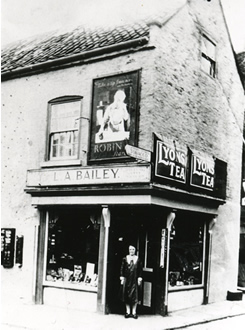
On the corner of Highbridge and Hailgate was 'La La' Bailey's shop (L.A. Bailey).
On the opposite side of Highbridge was Bertha Robinson's shop, a kind of tiny department store, selling clothes, bread,
toys, sweets, tobacco, biscuits. You never saw things weighed; the
scales were out of sight. When she retired she bought a very nice
bungalow on Boothferry Road.
